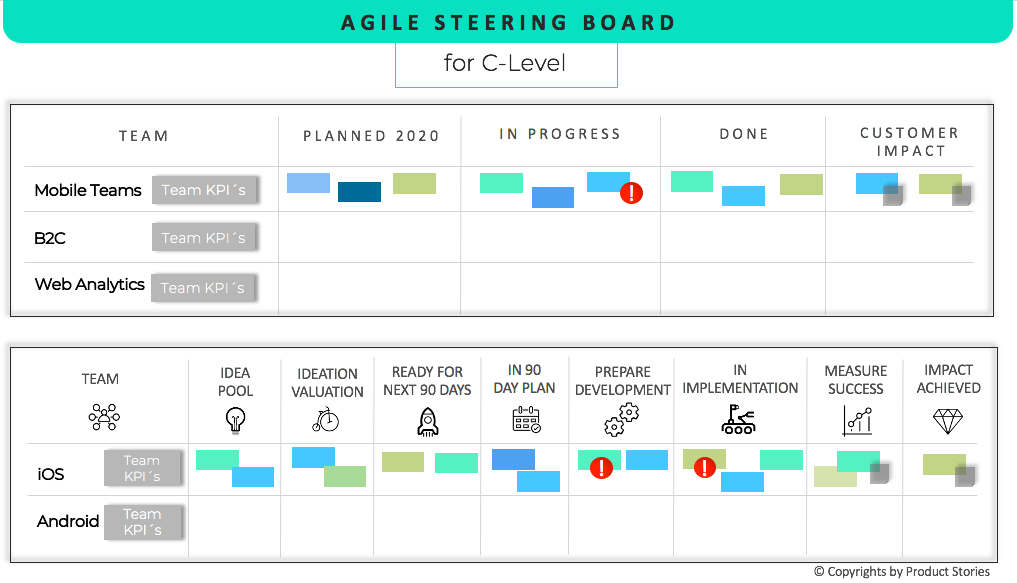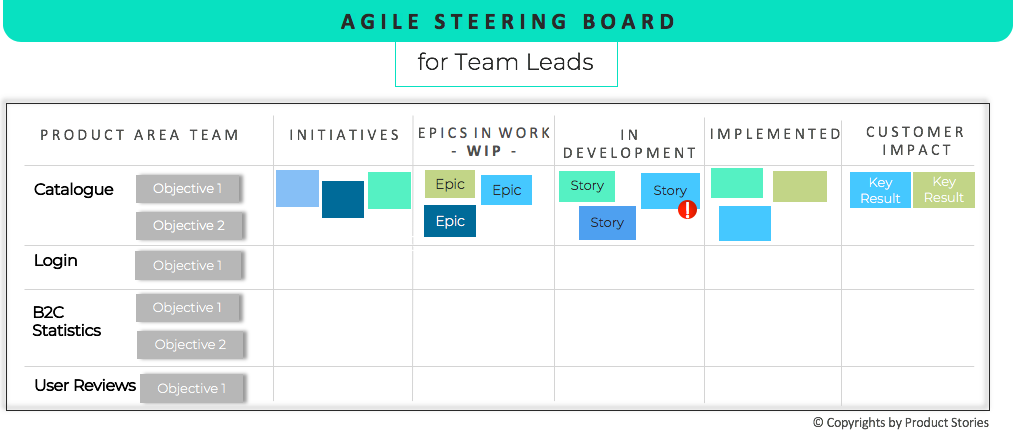
11 Feb. The Agile Steering Board
Agile organizations often struggle to fully oversee all ongoing activities. Agile teams do their best to create valuable products, but they encounter troubles when collaborating across many other teams. Thus, with having agile teams in place the work is not done. Quite the contrary, to ensure full coordination, collaboration and focus one has to get an overview of the whole picture – the complete portfolio – and needs to steer it.
Overlooking one´s portfolio is not only essential for product leaders, but can be used as method from C-level to product owners that are responsible for multiple Scrum teams. Depending on the level you might need to focus on different things e.g. a C-level lead needs to overlook the complete business portfolio whereas a lead product owner wants to have an overview over all activities of its product streams.
Set up the Board
Visualization is king. Let me introduce you to our king: The Agile Steering Board. It provides a comprehensive overview of all initiatives that are going on in your team or company. Set up like a Kanban board it aims at transparency and fosters communication across multiple agile teams, stakeholder and management. Planned releases, running sales and marketing campaigns, roll-out dates etc. will be communicated directly to everyone that might be affected (in)directly. By setting potential blockers and discussing dependencies on the spot with all relevant people decreases the risk of running down a wrong path. And, last but not least, it always keeps an eye on the customer value. Only if each team identifies its own contribution to the overall value for the customer, the whole business will succeed. The Agile Steering Board supports you in doing so by providing a dedicated column for customer impact that answers the question „What´s in it for the customer after all?“.
What the board shows
I share two examples of Agile Steering Boards for different levels. Please note that those are only examples that can and have to be adjusted to your very individual needs at any point. Hover over the image to get to get more details.

How it works!
The Agile Steering Board is the key piece of a regular session that is set up for all relevant teams and stakeholder incl. management. The board should be set up on a dedicated spot or room that fits all people you need to invite. You can easily invite remote teams too by placing a camera on the board and make people attend via video conference. Then you walk the board the same way you´re used to do it with a Kanban board: start from the right (What has been achieved?) and go to the left side (What are we going to work on?). Each team representative gives a short update on the done work, upcoming work and KPIs. Potential impediments and dependencies are raised and revealed immediately as they are identified. The biggest benefit of an Agile Steering Board is the transparency it creates and its power to remove obstacles on the spot. Make use of these benefits as much as possible.
Who attends?
Especially if the board is set up for C-level attendees usually all product teams as well as department representatives from marketing, sales, customer service, legal, data analytics and so on are invited. The invitation and facilitation have to come from the management clearly! That´s a crucial point as only in this way you´ll get the according commitment from all sides and provoke management decisions fast.
Agile Steering Boards for Product Leads require that your Product Team Lead and all relevant product teams e.g. B2C and B2B product team, platform team and mobile teams etc. are present. Please do not forget your friends from marketing, sales or data analytics and so on. Whoever, you think has an interest and stake in contributing to the overall customer value should be invited.
How often should a session take place?
This depends on the flight level: for C-level boards I recommend a bi-weekly rhythm of 60 minutes max. For Product Leads more frequent sessions might make sense e.g. a weekly rhythm. However, if you feel that is too much, extend it to twice a month up to once a quarter depending on your needs.

How do the two boards differ?
Agile Steering Boards can be set up on different flight-levels. Hence, different people will use the board and work with its content. Therefore, the granularity of relevant initiatives as well as the details of their progress may vary. For example, it may be more relevant for the Chief Product Officer to get transparency over company-wide product initiatives e.g. get more small retailers on the platform (initiative of a B2B team) or establish partner API (initiative a Platform team). Compared to the interests of a Product Team Lead or Group Product Owner who rather wants to get an overview over particular stories and their progress across product teams.
Also, KPIs or objectives may vary depending on the level of the board. Whereas a CPO looks at a team´s goals by measuring “the number of small retailers on the platform”, a Product Team Lead may be interested in the conversion rate of a specific product.
The Agile Steering Board is a practical method to encounter the lack of coordination, collaboration and focus across agile teams, and is an answer to the misbelief about agile teams creating value whatsoever.
Written by Sabrina Rzepka
.
- – sharing is caring –
